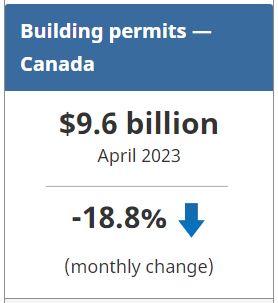Statistics Canada: Building Permits April 2023
The total monthly value of building permits in Canada dropped 18.8% to $9.6 billion in April, the lowest level since December 2020.

On a constant dollar basis (2012=100), the total value of building permits fell 18.5% to $5.6 billion in April 2023.
Non-residential permits down following the strongest month on record
Following a record high in March, the total monthly value of non-residential permits fell 34.6% to $3.4 billion in April. The drop was observed across all components but was most pronounced in commercial (-40.2% or – $1.1 billion) and industrial (-49.6% or -$663.8 million) construction intentions.
On a seasonally unadjusted basis, the average commercial permit was valued at $433,000 in April compared with $901,000 in March. Similarly, the average industrial permit was valued at $413,000 in April compared with $1.7 million in March. The significantly lower average permit values show that the monthly declines in April are attributed to exceptionally high volumes of large-scale projects in March.
Residential construction intentions down for eight provinces
The total monthly value of residential permits declined 6.1% to $6.1 billion, sliding for the second consecutive month. Declines were posted for both the single-family and multi-dwelling components.
Ontario (down 10.5% or -$296.4 million) greatly contributed to the monthly decrease in the residential sector.
British Columbia (up 2.6% or +$35.1 million) and Saskatchewan (up 45.0% or +$15.2 million) were the two provinces to post monthly growth in residential construction intentions.
To explore data using an interactive user interface, visit the Building permits: Interactive Dashboard.
For more information on construction, please visit the Construction statistics portal.
For more information on housing, please visit the Housing statistics portal.
Statistics Canada has a Housing Market Indicators dashboard. This web application provides access to key housing market indicators for Canada, by province and by census metropolitan area. The indicators are updated automatically with new information from monthly releases, giving users access to the latest data.
Note to readers
Unless otherwise stated, this release presents seasonally adjusted data with current dollar values, which facilitate month-to-month and quarter-to-quarter comparisons by removing the effects of seasonal variations. For information on seasonal adjustment, see Seasonally adjusted data – Frequently asked questions.
Building components
- Single-family dwellings: Residential buildings containing only one dwelling unit (e.g., single-detached house, bungalow, linked home [linked at the foundation]).
- Multi-family dwellings: Residential buildings containing multiple dwelling units (e.g., apartment, apartment condominium, row house, semi-detached house).
- Industrial buildings: Buildings used in the processing or production of goods or related to transportation and communication.
- Commercial buildings: Buildings used in the trade or distribution of goods and services, including office buildings.
- Institutional and government buildings: Buildings used to house public and semi-public services, such as those related to health and welfare, education or public administration, and buildings used for religious services.
Revision
Data are subject to revisions based on late responses, methodological changes and classification updates. Unadjusted data has been revised for the previous month. Seasonally adjusted data has been revised for the previous three months.
For information on trend-cycle data, see the StatCan Blog and Trend-cycle estimates – Frequently asked questions.
Next release
Data on building permits for May will be released on July 10.
Source: Statistics Canada

